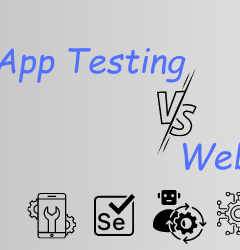07 Feb

In the rapidly evolving landscape of technology, mobile applications have become an integral part of our daily lives. As more businesses and services shift towards mobile platforms, the importance of mobile testing has grown exponentially. Keeping up with the latest mobile testing trends is crucial for ensuring app quality, performance, and user satisfaction. In this blog, we will explore the key trends shaping the world of mobile testing.
➤ Automated Testing for Mobile Apps
Automation in mobile testing is not a new concept, but its significance continues to rise. Automated testing helps in speeding up the testing process, reducing human errors, and ensuring consistent results. Tools like Appium, Selenium, and Espresso are widely used for automating mobile testing.
Benefits of Automated Mobile Testing:
Faster Test Cycles: Automation significantly reduces the time required for repetitive testing tasks.
Improved Accuracy: Automated tests eliminate human errors, providing more reliable results.
Scalability: Automated tests can be easily scaled to cover a wide range of devices and OS versions.
➤ Cross-Platform Testing
With the diversity of mobile devices and operating systems, cross-platform testing has become essential . Tools like Xamarin, Flutter, and React Native enable developers to create applications that run seamlessly on multiple platforms. Cross-platform testing ensures that the app performs well on both Android and iOS devices.
Key Aspects of Cross-Platform Testing:
Consistency: Ensures a uniform user experience across different platforms.
Efficiency: Reduces the time and effort needed to test separate codebases for different platforms.
Cost-Effective: Minimizes development and testing costs by using a single codebase.
➤ Continuous Integration and Continuous Deployment (CI/CD)
CI/CD practices have revolutionized the software development lifecycle, including mobile app development and testing. By integrating testing into the CI/CD pipeline, teams can identify and fix issues early, ensuring faster releases and higher quality apps.
Advantages of CI/CD in Mobile Testing:
Early Bug Detection: Continuous testing helps in identifying issues at an early stage, reducing the cost of bug fixes.
Faster Releases: Automation in the CI/CD pipeline accelerates the release cycle, allowing more frequent updates.
Enhanced Collaboration: CI/CD fosters better collaboration between development and testing teams.
➤ Security Testing
As mobile apps handle more sensitive data, security testing has become a critical aspect of mobile testing. Ensuring that an app is secure from vulnerabilities such as data breaches, unauthorized access, and other security threats is paramount.
Focus Areas in Mobile Security Testing:
Data Encryption: Ensuring that data transmitted and stored by the app is encrypted.
Authentication: Verifying that the app has robust authentication mechanisms.
Vulnerability Scanning: Regularly scanning the app for known security vulnerabilities.
➤ Performance Testing
Performance testing is essential to ensure that an app provides a smooth and responsive user experience. It involves testing the app under various conditions to evaluate its performance metrics such as load time, responsiveness, and stability.
Performance Testing Strategies:
Load Testing: Assessing the app’s performance under peak load conditions.
Stress Testing: Evaluating how the app behaves under extreme conditions.
Battery Usage: Ensuring that the app does not drain the device’s battery excessively.
➤ User Experience Testing
User Experience (UX) is a critical factor in the success of a mobile app. UX testing focuses on the app’s usability, design, and overall user satisfaction. Gathering feedback from real users and incorporating it into the development process is vital.
UX Testing Techniques:
Usability Testing: Observing real users as they interact with the app to identify usability issues.
A/B Testing: Comparing different versions of the app to determine which one performs better in terms of user engagement.
Feedback Collection: Using surveys and in-app feedback tools to gather user opinions.
Conclusion
Staying updated with the latest mobile testing trends with QA Craft . By embracing automated testing, integrating AI and ML, focusing on cross-platform compatibility, and adopting CI/CD practices, developers can ensure that their apps meet the high standards expected by today’s users. For more information call us today on (+91) 9157 786 796 or mail us on inquiry@qacraft.com.




Priyanka Kanthariya